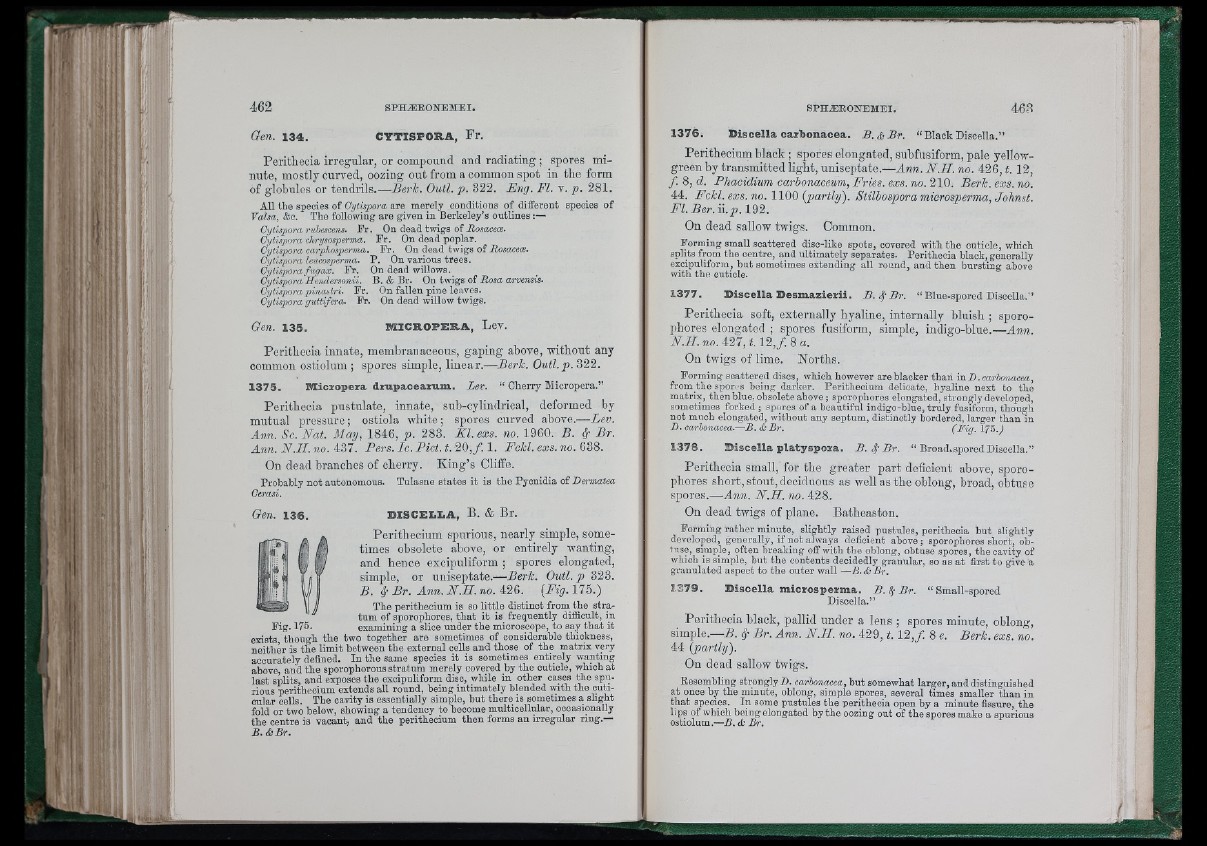
/J
Gen. 1 3 4 . CYTISPORA, Er.
Perithecia irregular, or compound and radiating ; spores minute,
mostly curved, oozing out from a common spot in the form
of globules or tendrils.—Berh. Outl. p. 822. Eng. Fl. v. p. 281.
All tlie species of Oytispora are merely conditions of different species of
Valsa, &c. The following are given in Berkeley’s outlines :—
Oytispora ruhescens. Fr. On dead twigs of Rosacece.
Oytispora chrysosperma. Fr. On dead poplar.
Oytispora carphosperma. Fr. On dead twigs of Rosacem.
Oytispora leucosperma. P. On various trees.
Oytispora fugax. Fr. On dead willows.
Oytispora Hendersonii. B. & Br. On twigs of Aom ar»e?isis.
Oytisporapinastri. Fr. On fallen pine leaves.
Oytispora guttifera. Fr. On dead willow twigs.
Gen. 1 3 5 . M ICROPERA , Lev.
Perithecia innate, membranaceous, gaping above, without any
common ostiolum ; spores simple, linear.—Berh. Outl.p. 322.
1 3 7 5 . M ic z o p e ia dzTip ac e azum. Lev. “ Cherry Micropera.”
Perithecia pustulate, innate, sub-cylindrical, deformed by
mutual pressure; ostiola white; spores curved above.— L e v .
Ann. Sc. Nat. May, 1846, p. 283. Kl. exs. no. 1960. B. / Br.
Ann. N .H.no. 481. Pers. Ic. Piet. t.20, f . l . Fckl. exs. no. 688.
On dead branches of cberry. King’s Cliffe.
Probably not autonomous. Tulasne states it is the Pycnidia of Dermatea
Cerasi.
Gen. 1 3 6 . DISCE L LA, B. & Br.
Perithecium spurious, nearly simple, sometimes
obsolete above, or entirely wanting,
and hence excipuliform ; spores elongated,
simple, or nniseptate.—Berh. Outl. p 323.
B . 4 Br. Ann. N .H . no. 426. [Fig. 175.)
The perithecium is so little distinot from the stratum
of sporophores, that it is frequently difficult, in
examining a slice under the microscope, to say that it
Fig. 175.
exists though the two together are sometimea of considerable thickness,
neither is the limit between the external cells and those of the matrix vwy
accurately defined. In the same species it is sometimes entirely wanting
above, and the sporophorous stratum merely covered by the cuticle, which at
last splits, and exposes the excipuliform disc, while in other cases the spurious
perithecium extends all round, being intimately blended with the cuti-
oular cells. The cavity is essentially simple, but there is sometimes a, slight
fold or two below, showing a tendency to become multicellular, occasionally
the centre is vacant, and the perithecium then forms an irregular ring.—
B .A B r .
1 3 7 6 . D is c e lla ca zb ona c ea . B .A B r . “ Black Disoella.”
Peritbecium black ; spores elongated, subfusiform, pale yellow-
green by transmitted ligbt, uniseptate.—A n n .N .H .n o . 426, t. 12,
f . 8, d. Phacidium carhonaceum, Fries, exs. no. 210. Berh. exs. no.
44. Fchl.exs.no. 1166 {partly). Stilhosporamicrosperma, Johnst.
F l. Ber. ii.)>. 192.
On dead sallow twigs. Common.
Forming small scattered diso-like spots, covered with the cuticle, which
splits from the centre, and ultimately separates. Perithecia black, generally
excipuliform, but sometimes extending all round, and then bursting above
with the cuticle.
1 3 7 7 . D is c e lla D e sm a z ie z ii. B . ^ P r . “ Blue-spored Discella.'’
Peritbeoia soft, externally byaline, internally bluisb ; sporo-
pbores elongated ; spores fusiform, simple, indigo-blue.—Ann.
N .II. no. 4 2 7 ,1.12, f . 8 a.
On twigs of lime. Norths.
Forming scattered discs, which however are blacker than mD.carhonacea,
from the spores being darker. Perithecium delicate, byaline next to the
matrix, then blue, obsolete above; sporophores elongated, strongly developed,
sometimes forked ; spores of a beautiful indigo-blue, truly fusiform, though
not much elongated, without any septum, distinctly bordered, larger than in
D. carhonacea.—B .A B r . (Fig. 175.)
3.378. D is c e lla p la ty sp o za . B . 4 B r. “ Broad-sporedDisoella.”
Peritbeoia small, for tbe greater part deficient above, sporo-
pbores sbort, stotit, decidnous as well as tbe oblong, broad, obtuse
spores.—Ann. N .H . no. 428.
On dead twigs of plane. Batheaston.
Forming rather minute, slightly raised pustules, perithecia but slightly
developed, generally, if not always deficient above ; sporophores short, obtuse,
simple, often breaking off with the oblong, obtuse spores, the cavity of
which is simple, but the contents decidedly granular, so as at first to give a
granulated aspect to the outer wall —B.ABr.
3 3 7 9 . D is c e lla m ic z o sp e zm a . B . S¡ B r.
Discella.”
“ Small-spored
Perithecia black, pallid under a lens ; spores minute, oblong,
simple.—D. / Br. Ann. N .H . no. 4 2 9 ,1.12, f . 8 e. Berh. exs. no.
44 {partly).
On dead sallow twigs.
Resembling strongly D. carhonacea, but somewhat larger, and distinguished
at once by the minute, oblong, simple spores, several times smaller than in
that species. In some pustules the peritheeia open by a minute fissure, the
lips of which being elongated by the oozing out of the spores make a spurious
ostiolum.—B. A Br.